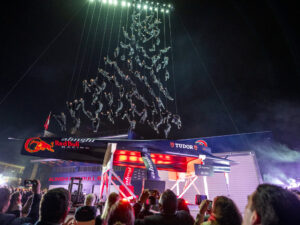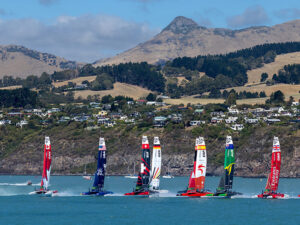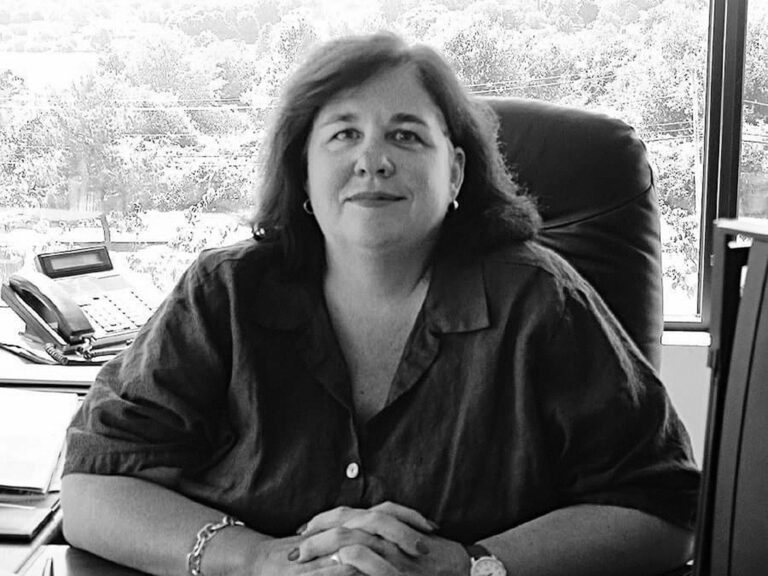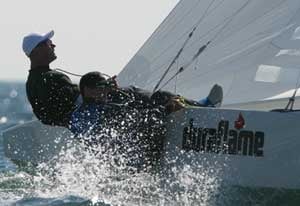
In the veteran-stacked fleet of Star boats at this winter’s Rolex Miami OCR, the soon-to-be-named Rolex Yachtsman of the Year was often lurking in the middle of the pack, trying to get back on top of the round-the-buoys game he’d left in favor of dodging equatorial squalls and Southern Ocean growlers in the Volvo Ocean Race. For the 38-year-old pro sailor from San Francisco, getting back in the groove hasn’t been easy as you’d expect, but he’s diving into the Olympic class, nonetheless, and waiting to punch his ticket into the next America’s Cup.
Your coach at the OCR, Anthony Kotoun, recently called us asking us for copies of any starting articles weve done. He said he you and Austin Sperry were having a hell of a time getting off the line at the Miami OCR. There are even rumors of second- and third-row starts. Whats the story?
Yeah, I guess we needed the articles to get a quick refresher. John [Burnham, the editor] sent down a bunch that really helped us brush up on the basics. There were a couple that I remember from Stuart Walker, Terry Hutchinson, and Chris Larson to name a few. They were all excellent.
So, what was it like for you, the 2003 Rolex Yachtsman of the Year, sitting in cheap seats?
It was frustrating, but believe it or not, it was good for us to spend some time at the back and have to work our way up.
Sounds like a case of the rusties. What was the problem with your starts?
It was basic stuff like positioning on the line, timing, and all of that. I guess the articles really helped because at the Bacardi Cup [two weeks later, he finished third] I dont remember ever having a bad start.
Howd you end up back in the Star after the Volvo Ocean Race?
Austin and I had talked about it for a while, even during the Volvo. After the Volvo, I didnt have the time or energy to put into it. But this winter the timing was right to do it right.
The Star fleets you sailed in at the OCR and at the Bacardi Cup were wild mixes of talented guys–there were super-veteran skippers Paul Cayard, Augie Diaz, and Mark Reynolds, middle-aged pros like yourself looking for another crack at a medal, and tough young blood like Andy Lovell. Did that make for some interesting racing or what?
I dont think the class has ever been healthier or stronger. It still has the same competitive vibe as it always has; there are many of the same people and every one is very professional on the racecourse. Its been a nice change from Farr 40 sailing, much less cutthroat. Theres a lot of respect among competitors and no petty protesting of minor fouls that dont affect the outcome of the race.
When you look at Mark Reynolds, do you see a guy whos got his work cut out for him this time around?
Hes been a leader in this class for so long that its probably about time some new faces came to the front. But were still a year away from our Olympic trials and he can turn it around quickly once he focuses. Its going to be hard against the younger guys who can sail all the time and dont have marriages and family. Im old, but Im not married and I dont have kids. [Eds note:Kostecki is now engaged.]
Did I hear you say youre old?
Yeah, Im getting up there.
Lets switch over to the recent Americas Cup match. What are your impressions of what went down in Auckland?
Well, a long ways back, way before it all started in October, I picked Team Alinghi outright. Actually, now that you mention it, Im glad you brought this up because it reminds me that I have a few outstanding bets to collect.
You were involved with Michael Illbrucks German challenge, which backed out well before Louis Vuitton Cup. Whats the status with that team?
Were still trying to raise money enough money to make the Pinta Challenge happen. We are giving ourselves until this spring, likely May, to make it happen. If not, were going to stop raising money.
Wouldnt Alinghis protocol for the 2007 match, and having the event in Europe help a German effort shore up sponsorship.
Itll definitely help, and the things theyre proposing are all good. The nationality requirement change had to happen. Its really going to save a lot of money for any team. Before, you would spend millions of dollars on accommodations in a country that you werent even using most of the time, and paying taxes in that country, too. Their changes definitely bring the event into modern times. The fleet racing and the change of schedule are excellent: the more racing the better, and if youre able to race and spread it out over several years, it will keep it fresh and provide better value for sponsors.
The Alinghi compound was more “open” to the public than others in the past; is this something you think well see more of next time?
We tried to have something like that at AmericaOne, but at the end of the day, we didnt have enough time and money to have it developed. I think Alinghi did it properly and I hope teams in the future will be more open like that. To get the public more involved, similar to Formula 1 and NASCAR racing where you can go to the pit and check everything out, is important.
|
|
| |
|
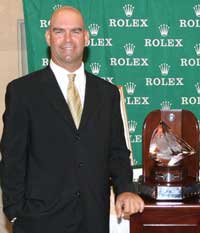
|
| |
| Dan Nerney/Rolex|
| |
|
|
| |
| John Kostecki won his second Rolex Yachtsman of the Year trophy largely due to his win in the 2001-02 Volvo Ocean Race. He’s now focusing on his Olympic campaign.* * *|
| |
|
|
|
If the Pinta Challenge does happen, where do you see yourself on the boat?
It depends on other people involved. Obviously, Id love to be on the boat and sailing–in charge of the whole sailing program, one way or another. During the Volvo we did some things well and we did some things poorly. Ive learned a lot from that experience; the most important is to get good people that are team players, which makes managing them easier or non-existent. Ultimately you spend more time sailing and developing rather than managing people.
Speaking of the Volvo, there are a number of big changes for the next event in 2005. Youve said it was a shame the Volvo 60s were ditched and that you would have preferred to see something similar to the big catamarans used for The Race.
The big multihulls seem to be the wave of the future. I was hoping that Volvo would make the big jump, but I can understand their logic. I have a few concerns with the current format, though. We advocated saving money for the teams to be competitive, and now they have to build a 70-foot boat, which is going to be expensive. Im afraid the changes they made are not significant enough to get a good turnout. I hope Im wrong.
What do you think about the 70-footer and the proposal of fewer crew?
Its going to make it a lot harder on the crew. Its a bigger boat and will be harder to handle. The bigger boat will be a lot more demanding. It was a tough race before and I think the next will be tougher.
Does the in-port racing component put too much of a demand on the crew?
If anyone wants to take it to the highest level, they will need two dedicated teams–one for the offshore legs and one to do the inshore racing. I dont know . . . I just think the whole thing wasnt thought out all that well. Itll be intense because theyll have to have inshore experts, fly them around, and pay them.
So, are you out for the next Volvo?
At the moment, Im not planning on it. It seems Ive only recently recovered from the last one, and its hard to think about doing that type of racing again. It took me a lot longer to recover than I realized. I dont know why . . . physically and mentally . . . I didnt feel recovered until several months after the race. Its a strange thing and hard to explain . . . its a certain burnout and some serious physical recovery–youre just not yourself.
Youve expressed an interest in big multis, does this mean youd consider The Race? Have you been approached?
No, and I dont have a multihull background so I wouldnt be surprised if I never got contacted for something like that. My point in favoring the bit catamarans for the Volvo is simply to get those types of groups together into one and have a great event with as many as 15 boats rather than four or five, which I imagine is what both the Volvo or The Race will each have at best.
It seems your career options are actually simple at this point in your life.
Ill continue with the Olympic sailing and do more Farr 40 sailing on the European circuit with Michael Illbruck this year and some Farr 40 stuff in the States. Yeah, its pretty simple, which is nice.
In your spare time, are you working on a golf game or anything like that?
No golf game, but snowboarding and mountain-bike riding are my other obsessions. I try to get out on the mountains as much as possible, but this winter hasnt helped my snowboarding because I spent so much time training on the Star. It looks like Ill be getting back to snowboarding this spring.
Whats your mountain of choice?
From the Bay Area we can drive to Lake Tahoe, but I dont have a favorite. I will do some snowboarding in Austria with Michael Illbruck. Then well combine Farr 40 sailing with some snowboarding. Hes just like me–he works hard and plays hard. Thats my style.
Was your second Rolex Yachtsman of the Year Award surprising?
There were many other great guys nominated that couldve won. I was told it was an easy decision for the people who decide, which makes me feel great. But honestly, Ive been meeting so many new people since I returned to sailing in the States. Theres a ton of great sailors and young guys working hard at it, so its great to get the Rolex when Im surrounded by so much talent.



